30.09.2011: End of an era as Fermilab's Tevatron accelerates its last beam
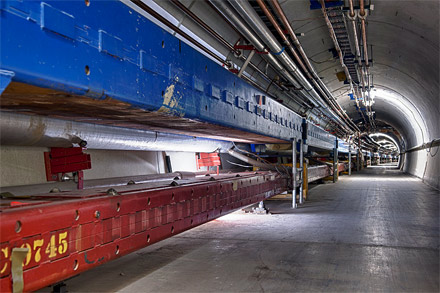
View of the Tevatron. Photo: Reidar Hahn / Fermilab.
Today the Tevatron particle accelerator at Fermi National Accelerator Laboratory in Batavia, Illinois, USA, will shut down after more than two decades at the forefront of high-energy physics. CERN's Large Hadron Collider will continue the adventure, advancing research at the high-energy frontier.
Starting at 9pm CEST today (2pm US Central), Fermilab will provide a half-hour live broadcast of shutdown activities in the control rooms for the accelerator and the two collider experiments, CDF and DZero. Fermilab Director Pier Oddone will speak about the Tevatron's legacy and the future of Fermilab.
More about the Tevatron's scientific legacy and Fermilab's future program is available in the October issue of the CERN Courier.
More information:
27.09.2011: TOTEM takes a new look at the proton
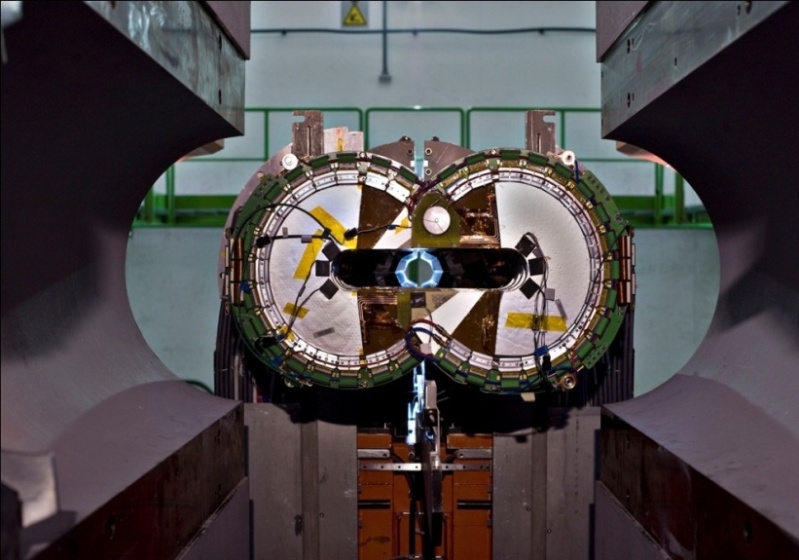
One component of the TOTEM detector during its installation.
The TOTEM experiment at the LHC has just published new results on the properties of protons. The experiment demonstrated that, at higher energies, protons behave as if they were becoming larger; their total cross-section – a parameter linked to the probability for interations between protons – increases with energy. This is the first time that the phenomenon has been confirmed at the LHC's unprecedented energy.
More information:
- CERN Bulletin: When the proton becomes larger
- CERN Courier: TOTEM probes new depths in pp elastic scattering
23.09.2011: OPERA experiment invites scrutiny of unexpected results
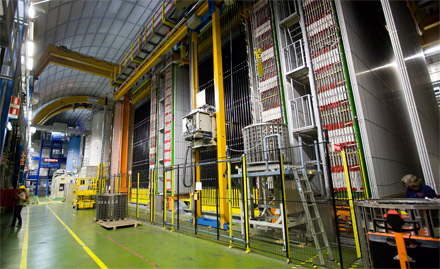
A view of the OPERA detector in Gran Sasso, Italy. Neutrino beams from CERN in Switzerland are sent over 700km through the Earth's crust to the laboratory in Italy.
The OPERA experiment, which observes a neutrino beam from CERN 730 km away at Italy's INFN Gran Sasso Laboratory, will present new results in a seminar at CERN today.
The OPERA result is based on the observation of over 15000 neutrino events measured at Gran Sasso, and appears to indicate that the neutrinos travel at a velocity 20 parts per million above the speed of light, nature’s cosmic speed limit. Given the potential far-reaching consequences of such a result, independent measurements are needed before the effect can either be refuted or firmly established. This is why the OPERA collaboration has decided to open the result to broader scrutiny.
More information:
- Press release: OPERA experiment reports anomaly in flight time of neutrinos from CERN to Gran Sasso
- The OPERA collaboration's result is available on the preprint server arxiv.org: http://arxiv.org/abs/1109.4897
- Quantum Diaries: Elementary, my dear neutrino...
- Quantum Diaries: Nothing travels faster than light but gossip!
- Video: Interviews with members of the OPERA collaboration
- Photos of the seminar on OPERA results at CERN
- Slides and video of the seminar
16.09.2001: Israel to become Associate Member State of CERN
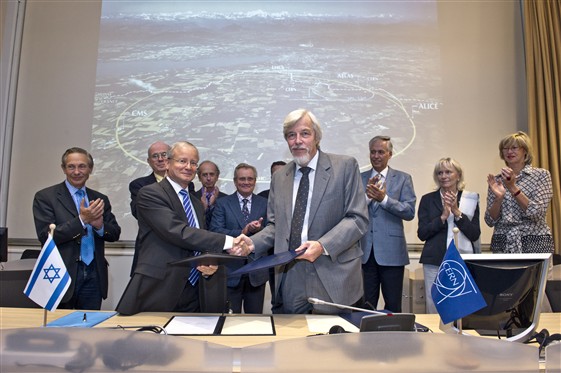
Israeli Ambassador and Permanent Representative of Israel to the United Nations Office and other International Organizations in Geneva, H.E. Mr. Aharon Leshno-Yaar and CERN Director General Rolf Heuer shake hands. More photos.
CERN Director General Rolf Heuer and Israeli Ambassador and Permanent Representative of Israel to the United Nations Office and other International Organizations in Geneva, H.E. Mr. Aharon Leshno-Yaar today signed a document admitting Israel to CERN Associate Membership, subject to ratification by the Knesset. Following ratification, Israel will become an Associate Member of CERN for a minimum period of 24 months. Following this period, CERN Council will decide on the admission of Israel to full Membership, taking into account the recommendations of a task force to be appointed for this purpose. Israel has a long-standing relationship with CERN, and has been an Observer at the CERN Council since 1991.
More information:
- Press release: Israel to become Associate Member State of CERN
13.09.2011: Sign up before 15 September: LHC control rooms to open for European Researchers' Night
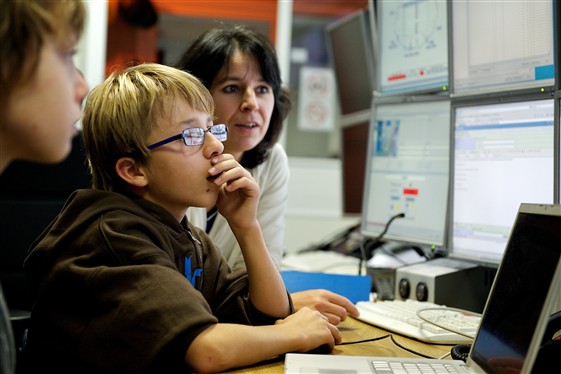
Young students in the ALICE control centre during European Researcher's night 2010.
To mark European Researchers' Night, CERN is inviting young people into the Large Hadron Collider's control rooms on the evening of 23 September. Students aged between 13 and 18 will have the unique opportunity of spending two hours alongside physicists running the LHC and its detectors.
More information:
05.09.2011: CERN announces Collide@CERN artists' residency programme
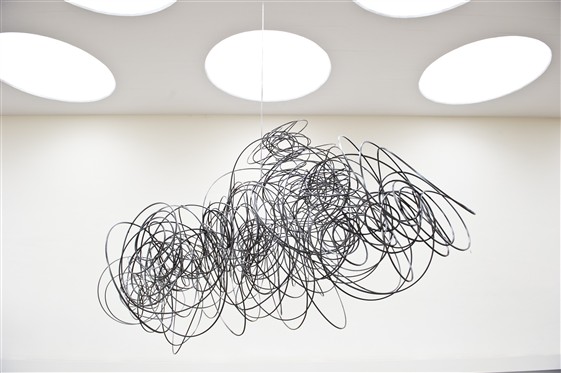
Feeling Material XXXIV by Antony Gormley was donated to CERN by the artist and now graces the main building. CERN's engagement with the arts is framed by a cultural policy that was announced in August this year. Learn more »
CERN's latest experiment – colliding the minds of scientists with the imagination of artists – begins with the Prix Ars Electronica Collide@CERN prize in digital arts. This is the first prize to be announced as part of the new Collide@CERN Artists Residency programme initiated by the laboratory.
This new prize marks a 3 year science/arts cultural partnership and creative collaboration between CERN and Ars Electronica.
More information:
30.08.2011: Lepton-photon conference 2011: LHC data shedding new light
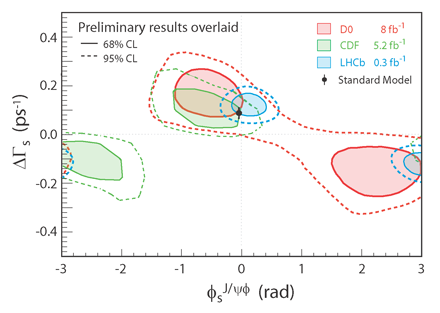
A data visualization from the LHCb experiment's results. LHCb's measurements of B meson decay correlate with Standard Model predictions – but they also indicate that there is still room for a contribution from new physics. IMAGE: LHCb collaboration
The biennial Lepton-Photon conference that has just wrapped up in Mumbai, India, saw the presentation of a number of new results from LHC experiments.
Among these results, LHCb physicists presented some of the most precise measurements yet on particles called B mesons, which provide a way to investigate matter-antimatter asymmetry. The LHCb experiment studies this phenomenon by observing the way B mesons decay into other particles.
Results from the ATLAS and CMS experiments show that the elusive Higgs particle, if it exists, is running out of places to hide. Proving or disproving the existence of the Higgs boson, which was postulated in the 1960s as part of a mechanism that would confer mass on fundamental particles, is among the main goals of the LHC scientific programme.
The LHC experiments also presented new results across a wide range of physics. Thanks to the outstanding performance of the LHC, the experiments and the Worldwide LHC Computing Grid, some of the current analyses are based on roughly twice the data sample presented at the previous major particle physics conference only a month ago.
More information:
- ATLAS website
- CMS website
- LHCb website
- Quantum diaries blog: LHCb is trying to crack the Standard Model
25.08.2011: CLOUD experiment provides unprecedented insight into cloud formation
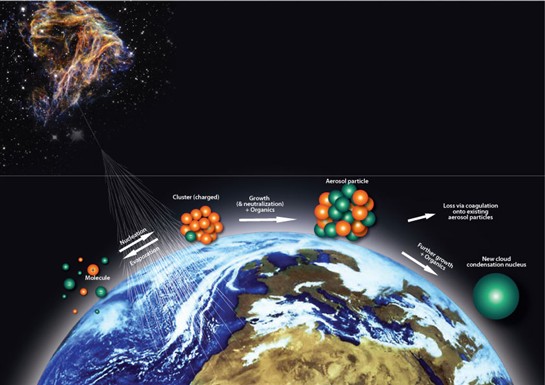
In a paper published in the journal Nature today, the CLOUD experiment at CERN has reported its first results. The CLOUD experiment has been designed to study the effect of cosmic rays on the formation of atmospheric aerosols - tiny liquid or solid particles suspended in the atmosphere - under controlled laboratory conditions. Atmospheric aerosols are thought to be responsible for a large fraction of the seeds that form cloud droplets. Understanding the process of aerosol formation is therefore important for understanding the climate.
The CLOUD results show that trace vapours assumed until now to account for aerosol formation in the lower atmosphere can explain only a tiny fraction of the observed atmospheric aerosol production. The results also show that ionisation from cosmic rays significantly enhances aerosol formation. Precise measurements such as these are important in achieving a quantitative understanding of cloud formation, and will contribute to a better assessment of the effects of clouds in climate models.
More information:
- Press release: CLOUD experiment provides unprecedented insight into cloud formation
- Video: CERN News - CLOUD
22.08.2011: LHC experiments present latest results at Mumbai conference
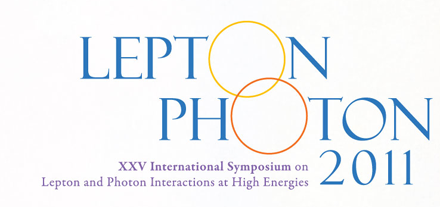
Results from the ATLAS and CMS collaborations, presented at the biennial Lepton-Photon conference in Mumbai, India today, show that the elusive Higgs particle, if it exists, is running out of places to hide.
Proving or disproving the existence the Higgs boson, which was postulated in the 1960s as part of a mechanism that would confer mass on fundamental particles, is among the main goals of the LHC scientific programme. ATLAS and CMS have excluded the existence of a Higgs over most of the mass region 145 to 466 GeV with 95 percent certainty.
More information:
- Press release: LHC experiments present latest results at Mumbai conference
15.08.2011: LHC control rooms to open for European Researchers' Night

Young students in the ALICE control centre during European Researcher's night 2010.
To mark European Researchers' Night, CERN is inviting young people into the Large Hadron Collider's control rooms on the evening of 23 September. Students aged between 13 and 18 will have the unique opportunity of spending two hours alongside physicists running the LHC and its detectors.
More information:
27.07.2011: CERN experiment weighs antimatter with unprecedented accuracy
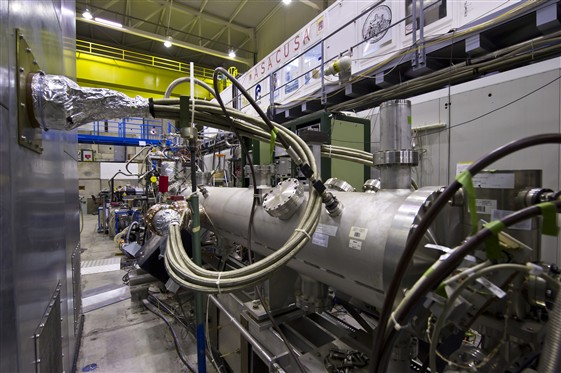
The ASACUSA experiment. More photos: 1 - 2.
In a paper published today in the journal Nature, the Japanese-European ASACUSA experiment at CERN reported a new measurement of the antiproton’s mass accurate to about one part in a billion. Precision measurements of the antiproton mass provide an important way to investigate nature’s apparent preference for matter over antimatter.
More information:
- Press Release: CERN experiment weighs antimatter with unprecedented accuracy
- Video: CERN News ASACUSA Experiment
- More photos: 1 - 2.
21.07.2011: LHC results announced at summer conferences
![[image]](../features/110721.png)
Photos: ALICE, ATLAS, CMS, LHCb.
The first of the major summer conferences in high-energy physics, EPS HEP 2011, has started in Grenoble, France. This important particle physics event brings together more than 600 physicists from all corners of the globe. It is a forum for collaborations, including those at the LHC, to present their latest analyses. Results are expected in all fields of research, from the search for the Higgs boson to the quest for dark matter and the understanding of antimatter.
More information:
- Press Release: LHC experiments present their latest results at Europhysics Conference on High Energy Physics
- Conference website: http://eps-hep2011.eu/
- Webcast of the plenary sessions: http://webcast.in2p3.fr/live/HEP2011
- Links to the experiments: ALICE, ATLAS, CMS, LHCb.
12.07.2011: Google science fair winners announced

This year's Google science fair winners are:
- Shree Bose (Grand prize winner, 17-18)
- Naomi Shah (winner, 15-16)
- Lauren Hodge (winner, 13-14)
One of the winners will have the opportunity to spend 3 days at CERN, visit labs and experimental areas, take part in shifts in the LHC experiments' control rooms, and experience science in the making, by taking an active role as an apprentice physicist.
CERN is a partner of the Google science fair.
More information:
07.07.2011 : CERN launches Open Hardware initiative
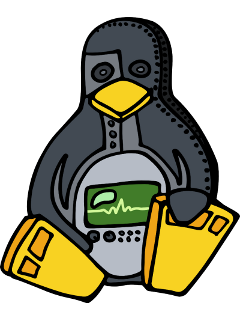
Four months after launching the alpha version, CERN has today issued version 1.1 of the Open Hardware Licence (OHL), a legal framework to facilitate knowledge exchange across the electronic design community.
In the spirit of knowledge and technology dissemination, the CERN OHL was created to govern the use, copying, modification and distribution of hardware design documentation, and the manufacture and distribution of products. Hardware design documentation includes schematic diagrams, designs, circuit or circuit-board layouts, mechanical drawings, flow charts and descriptive texts, as well as other explanatory material.
More information:
- Press release: CERN launches Open Hardware initiative
- CERN Courier: Hardware joins the open movement
- Open Hardware Repository: ohwr.org
- The full license text is available for download here